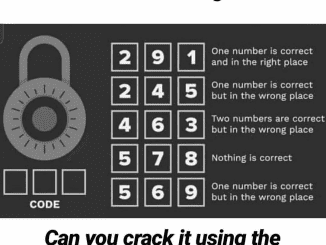Puzzles are not only a great way to challenge our minds, but they also help us enhance our observation skills and attention to detail. One particular type of puzzle that seems simple yet often leaves people stumped is the visual shape puzzle. Today, we’re looking at a seemingly straightforward question: “How many triangles do you see here?”
Take a moment to look at the image above. At first glance, it might look like just a few triangles stacked together. But wait—could there be more than you initially thought? Let’s dive into the puzzle, dissect common mistakes, and analyze the solution step by step. Are you ready to challenge your perception?
Why This Puzzle is Trickier Than It Seems

At first, counting the triangles might seem easy. You spot a few and think you’re done. However, many people miss a few hidden ones because they don’t take into account overlapping triangles or larger shapes formed by smaller triangles combined. This puzzle is a great reminder of how sometimes, what we see at first glance doesn’t capture the whole picture.
Common Mistakes People Make
- Counting Only the Smallest Triangles: Some might look at each individual segment without realizing that larger triangles are formed by combining smaller sections. This usually leads to underestimating the number of triangles.
- Ignoring Overlapping Shapes: When triangles overlap or share sides, people often overlook the new triangles that are created by these shared lines. In this case, overlooking overlapping shapes can lead to a miscount.
- Rushing Through: Since it looks like a simple puzzle, people tend to count quickly. However, a quick glance rarely reveals the entire truth. Taking your time and examining each detail makes a big difference in finding the correct answer.
To solve this puzzle accurately, you need to break it down step-by-step. Let’s walk through the solution.
Solving the Puzzle Step-by-Step
Here’s a breakdown of how you can approach this triangle puzzle and make sure you’ve counted each triangle.
Step 1: Count the Small Triangles
Start by looking for the smallest, individual triangles in the image. In the illustration, you’ll notice:
- Three small triangles formed at each horizontal level.
There are a total of three levels of small triangles.
Step 2: Count Medium-Sized Triangles
Once you’ve counted the smallest triangles, look for slightly larger triangles that are created by combining two or more small triangles. In this image:
- There are two medium triangles in the middle section.
This gives us two additional triangles, bringing the total count so far to five.
Step 3: Count the Largest Triangle
Now, take a look at the entire shape. The outline of the entire image forms one large triangle, which encompasses all the smaller and medium-sized triangles within it.
- One large triangle forms when you look at the entire shape as a single unit.
Total Number of Triangles

When we add up all the triangles we’ve identified:
- 3 small triangles
- 2 medium triangles
- 1 large triangle
This gives us a total of 6 triangles in the image.
Why Accuracy Matters in Puzzles Like This
Puzzles like these help train our minds to notice subtle details. By slowing down and breaking down the problem, you train yourself to think critically and observe carefully. The satisfaction of solving a seemingly simple but deceptive puzzle is rewarding, and it sharpens your mental abilities.
Share Your Answer!
So, how many triangles did you initially count? Did you find six on your first try, or did you end up with a different number? Comment below and share your answer! It’s always fun to see how others approached the puzzle and if they spotted all the triangles right away.
As a takeaway, consider trying more visual puzzles to improve your logic and reasoning skills. The more you practice, the better you’ll get at spotting those hidden details that often elude others. Keep challenging yourself, and enjoy the thrill of discovering solutions to tricky puzzles!


